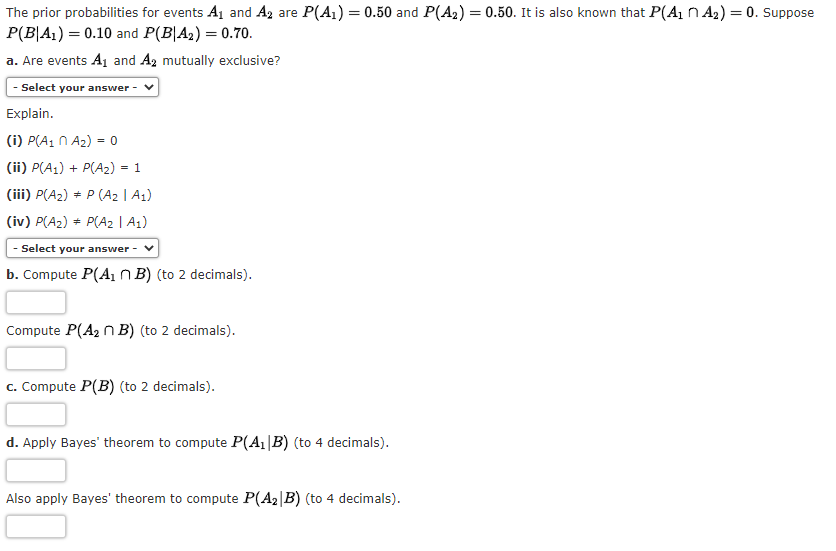The prior probabilities for events Aj and A2 are P(A1) 0.50 and P( = 0.50. It is also known that P(Ai N A2) = 0. Suppose P(B|A}) = 0.10 and P(B|A2) = 0.70. a. Are events A1 and A, mutually exclusive? - Select your answer - Explain. (i) P(A1 N A2) = 0 (ii) P(A1) + P(A2) = 1 (iii) P(A2) * P (A2 | A1) (iv) P(A2) * P(A2 | A1) - Select your answer - b. Compute P(A1 n B) (to 2 decimals).
The prior probabilities for events Aj and A2 are P(A1) 0.50 and P( = 0.50. It is also known that P(Ai N A2) = 0. Suppose P(B|A}) = 0.10 and P(B|A2) = 0.70. a. Are events A1 and A, mutually exclusive? - Select your answer - Explain. (i) P(A1 N A2) = 0 (ii) P(A1) + P(A2) = 1 (iii) P(A2) * P (A2 | A1) (iv) P(A2) * P(A2 | A1) - Select your answer - b. Compute P(A1 n B) (to 2 decimals).
College Algebra
7th Edition
ISBN:9781305115545
Author:James Stewart, Lothar Redlin, Saleem Watson
Publisher:James Stewart, Lothar Redlin, Saleem Watson
Chapter9: Counting And Probability
Section9.3: Binomial Probability
Problem 2E: If a binomial experiment has probability p success, then the probability of failure is...
Related questions
Question

Transcribed Image Text:The prior probabilities for events A1 and Az are P(A1) = 0.50 and P(A2) = 0.50. It is also known that P(A1 n A2) = 0. Suppose
P(B|A¡) = 0.10 and P(B|A2) = 0.70.
a. Are events Aj and Az mutually exclusive?
Select your answer -
Explain.
(i) P(A1 N A2) = 0
(ii) P(A1) + P(A2) = 1
(iii) P(A2) + P (A2 | A1)
(iv) P(A2) + P(A2 | A1)
- Select your answer - V
b. Compute P(A1 n B) (to 2 decimals).
Compute P(A2 n B) (to 2 decimals).
c. Compute P(B) (to 2 decimals).
d. Apply Bayes' theorem to compute P(A1|B) (to 4 decimals).
Also apply Bayes' theorem to compute P(A2|B) (to 4 decimals).
Expert Solution
This question has been solved!
Explore an expertly crafted, step-by-step solution for a thorough understanding of key concepts.
Step by step
Solved in 2 steps with 2 images

Recommended textbooks for you

College Algebra
Algebra
ISBN:
9781305115545
Author:
James Stewart, Lothar Redlin, Saleem Watson
Publisher:
Cengage Learning

College Algebra
Algebra
ISBN:
9781305115545
Author:
James Stewart, Lothar Redlin, Saleem Watson
Publisher:
Cengage Learning